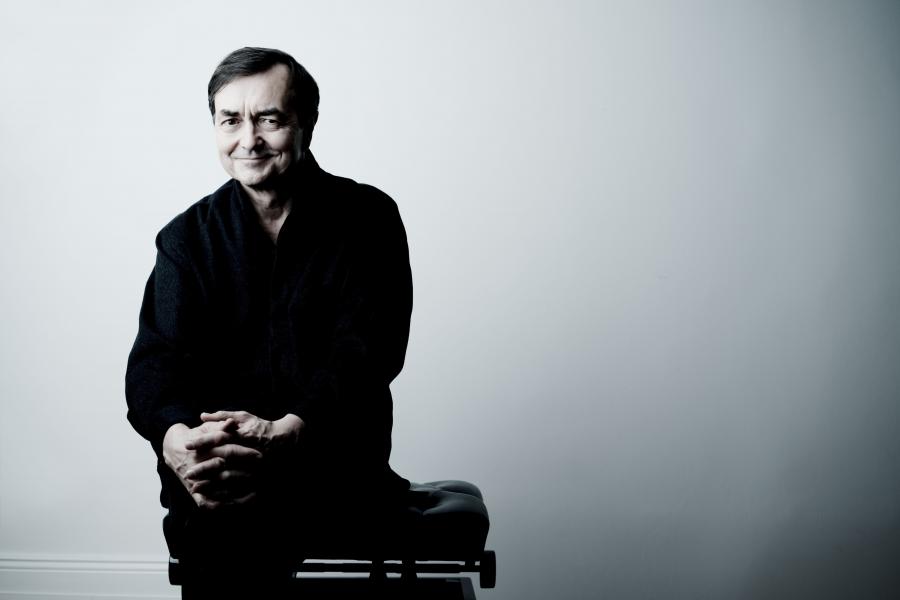Pierre-Laurent Aimard explores lonely landscapes in Shriver Hall series

Pierre-Laurent Aimard performed Sunday night for the Shriver Hall series. Photo: Marco Borggreve
A recital by Pierre-Laurent Aimard generally involves a revelatory pairing of old and new music, with delights both virtuosic and intellectual. The French pianist, who last appeared at Shriver Hall in 2008, returned to the Baltimore series Sunday evening for just that kind of program. With Shriver Hall’s renovation now extended until early 2019, the recital was moved to Kraushaar Auditorium, on the campus of Goucher College in Towson.
Aimard replaced the opening work, Nikolai Obukhov’s Révélation, with a movement from Messiaen’s Catalogue d’Oiseaux, a complete recording of which is on his his first release for the Pentatone label. In “Le Courlis cendré,” a darkly voiced minor chord immediately evoked the gloomy solitude of the coast of Brittany, where Messiaen recorded the call of the titular bird, the Eurasian curlew.
Its call, represented bitonally in the opening bars, sparked answers from other birds, as well as the palmed cluster of notes representing the deafening foghorn of a lighthouse. Throughout the piece Aimard displayed a Lisztian virtuosity, shifting registers with ease. Countless gradations of soft dynamics piled up, especially in an echoing phrase made just slightly softer in each iteration.
Ligeti composed his Musica ricercata from 1951 to 1953, a youthful dalliance with self-imposed creative restrictions. Aimard, who recorded the piece for Sony’s György Ligeti Edition, played up the nutty drama of the opening movement, written almost entirely with just the pitch A. Ligeti adds D at the end, establishing the possibility of tonality with this interval, the basic building block.
To make up for the paucity of pitch variety, Ligeti ramps up the rhythmic appeal, making the first movement into a vivacious one-note march, perhaps recalling the janissary section of Beethoven’s Ninth Symphony. As Ligeti added a new pitch class in each movement, new vistas appeared. A semitone in the second movement began to imply the minor mode, and thirds in the third movement made chords possible, with arpeggiations and horn calls.
The fourth movement broke into an enthusiastic waltz, even though the composer could use basically only two chords, thanks to a shift of bass note. The major mode came into view in the sixth movement, limned by Aimard as a soft Debussy-esque watercolor scene. Aimard is often best in making short movements or pieces intensely and individually colored, so that the end of the piece, with its homage to Bartók and densely chromatic fugue à la Frescobaldi, never flagged in interest.
Beethoven’s Sonata No. 29 in B-flat was the sole work after intermission. Aimard again explored all the diverting nooks and crannies of this epic “Hammerklavier” sonata, without really synthesizing an overall conception of the larger form. The opening of the first movement was reserved, but Aimard is not really known as a “shock and awe” sort of pianist. At times, in that initial motif and again at the end of the sonata, Aimard searched fruitlessly for a range of forte dynamics, seemingly beyond what the Steinway could supply. This movement was strongest in the fugal section of the development, where each contrapuntal voice had a slightly different color distinguishing it in the intertwined braid of music.
Aimard excelled in the slender scherzo of the second movement, trading off jocular riffs with howls of despair. He did not quite succeed in the heart of this sonata, the anguished operatic aria of the third movement, as a clipped tempo and excessive pedaling obscured some details. This movement should prepare the listener for the audacious levity of the concluding fugue with its signature gesture, a flippant trill. Instead, the fugue eclipsed what had come before, set at a dazzling tempo and more vehement with each page turned.
It should be noted that Aimard delayed the performance after the Messiaen piece, in order to have the auditorium’s noisy heating system turned off. “There are always unexpected enemies for lovers of music,” he quipped before starting the Ligeti work. When the noise finally stopped, in the second movement of the Ligeti set, it made one realize how deleterious it had been to the hall’s otherwise good acoustic.
Bass-baritone Eric Owens and pianist Myra Huang are the next performers on the Shriver Hall series, 5:30 p.m. March 25 at Baltimore Hebrew Congregation. shriverconcerts.org; 410-516-7164.








Posted Mar 12, 2018 at 9:50 pm by Patrick
Are reviews on this site intended primarily for the cognescenti? Or as a venue for the author to parade his musical erudition? However, I doubt the man on the street has any idea what a ‘pitch class’ is and would be turned off by the non-interest in actual communication. Among other references.